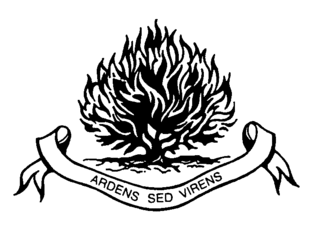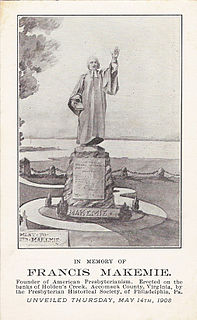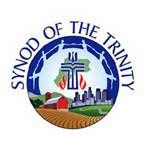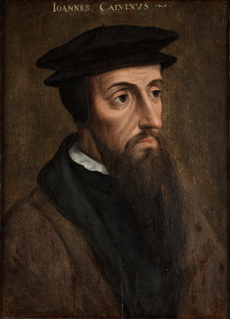
Presbyterianism is a part of the Reformed tradition within Protestantism, which traces its origins to Great Britain, specifically Scotland.

The Presbyterian Church (USA), abbreviated PC(USA), is a mainline Protestant denomination in the United States. A part of the Reformed tradition, it is the largest Presbyterian denomination in the US, and known for its relatively progressive stance on doctrine and ordains women and LGBT community as elders and ministers. The PC(USA) was established by the 1983 merger of the Presbyterian Church in the United States, whose churches were located in the Southern and border states, with the United Presbyterian Church in the United States of America, whose congregations could be found in every state. The similarly named Presbyterian Church in America is a separate denomination whose congregations can also trace their history to the various schisms and mergers of Presbyterian churches in the United States.
Presbyterianpolity is a method of church governance typified by the rule of assemblies of presbyters, or elders. Each local church is governed by a body of elected elders usually called the session or consistory, though other terms, such as church board, may apply. Groups of local churches are governed by a higher assembly of elders known as the presbytery or classis; presbyteries can be grouped into a synod, and presbyteries and synods nationwide often join together in a general assembly. Responsibility for conduct of church services is reserved to an ordained minister or pastor known as a teaching elder, or a minister of the word and sacrament.

The Cumberland Presbyterian Church is a Presbyterian Christian denomination spawned by the Second Great Awakening. In 2015, it had 70,810 members and 709 congregations, of which 51 were located outside of the United States. The word Cumberland comes from the Cumberland River valley where the church was founded.

The Non-subscribing Presbyterian Church of Ireland is a non-creedal Christian Church, which maintains a great emphasis on individual conscience in matters of Christian faith.

The Presbyterian Church in Canada is a Presbyterian denomination, serving in Canada under this name since 1875. The United Church of Canada claimed the right to the name from 1925 to 1939. According to the Canada 2001 Census 409,830 Canadians identify themselves as Presbyterian, that is, 1.4 per cent of the population.

The Presbyterian Church in the United States of America (PCUSA) was the first national Presbyterian denomination in the United States, existing from 1789 to 1958. In that year, the PCUSA merged with the United Presbyterian Church of North America, a denomination with roots in the Seceder and Covenanter traditions of Presbyterianism. The new church was named the United Presbyterian Church in the United States of America. It was a predecessor to the contemporary Presbyterian Church (USA).

Francis Makemie (1658–1708) was an Ulster Scots clergyman, considered to be the founder of Presbyterianism in United States of America.

The Reformed Church in the United States (RCUS) is a Protestant Christian denomination in the United States. The present RCUS is a conservative, Calvinist denomination. It affirms the principles of the Reformation: Sola scriptura, Solus Christus, Sola gratia, Sola fide, and Soli Deo gloria. The RCUS has membership concentrated in South Dakota, Colorado, and California.

The New Castle Presbytery is the parent organization of the 55 churches, 120 ministers, and 12,000 members of the Presbyterian Church (USA), Synod of Mid-Atlantic covering Delaware and the Maryland Eastern Shore. The Presbytery was formed in 1717 after the division of the Presbytery of Philadelphia into three presbyteries, which were subordinate to the newly formed Synod of Philadelphia.

Synod of the Trinity is an upper judicatory of the Presbyterian Church headquartered in Camp Hill, Pennsylvania. The synod oversees sixteen presbyteries covering all of Pennsylvania, most of West Virginia, and a portion of eastern Ohio.
John Thomson or Thompson was born in Ireland and became a minister in the Presbytery of Philadelphia, later the Synod of Philadelphia. He served as a missionary in both Virginia and North Carolina, where he died a natural death in 1753. He is buried in the cemetery of Centre Presbyterian Church in Mooresville, North Carolina.
The Old Side–New Side Controversy occurred within the Presbyterian Church in Colonial America and was part of the wider theological controversy surrounding the First Great Awakening. The Old and New Side Presbyterians existed as separate churches from 1741 until 1758. The name of Old Side–New Side is usually meant as specifically referring to the Presbyterian Church. When one is referring to the debate as a whole, Old and New Light is usually used.

The Old School–New School Controversy was a schism of the Presbyterian Church in the United States of America which took place in 1837 and lasted for over 20 years. The Old School, led by Charles Hodge of Princeton Theological Seminary, was much more conservative theologically and did not support the revival movement. It called for traditional Calvinist orthodoxy as outlined in the Westminster standards.

The Reformed Presbyterian Church of North America (RPCNA) is a Presbyterian church with congregations and missions throughout the United States, Canada, and Japan. Its beliefs—formulated via membership in the Reformed Presbyterian Church and RP Global Alliance—place it in the conservative wing of the Reformed family of Protestant churches. Below the Bible—which is held as divinely inspired and without error—the church is committed to several "subordinate standards," together considered with its constitution: the Westminster Confession of Faith and Larger and Shorter Catechisms, along with its Testimony, Directory for Church Government, the Book of Discipline, and Directory for Worship.

The Reformed Presbyterian Church of Scotland is a small, Scottish, Presbyterian church denomination. Theologically they are similar to many other Presbyterian denominations in that their office-bearers subscribe to the Westminster Confession of Faith. In practise they are more theologically conservative than most Scottish Presbyterians and maintain a very traditional form of worship. In 1690, after the Revolution, Alexander Shields joined the Church of Scotland, and was received along with two other ministers. These had previously ministered to a group of dissenters of the United Societies at a time when unlicensed meetings called conventicles were outlawed. Unlike these ministers, some Presbyterians did not join the reconstituted Church of Scotland. From these roots the Reformed Presbyterian Church of Scotland was formed. It grew until there were congregations in several countries. In 1876 the majority of Reformed Presbyterians, or RPs, joined the Free Church of Scotland, and thus the present-day church, which remained outside this union, is a continuing church. There are currently Scottish RP congregations in Airdrie, Stranraer, Stornoway, Glasgow, and North Edinburgh. Internationally they form part of the Reformed Presbyterian Communion.

Presbyterianism has had a presence in the United States since colonial times and has exerted an important influence over broader American religion and culture.
The Adopting Act of 1729 is an act of the Synod of Philadelphia that made the Westminster Standards, particularly the Westminster Confession of Faith, the official confessional statements for Presbyterian churches in colonial America. Presbyterian ministers were required to believe or "subscribe" to the "essential and necessary" parts of the standards, but defining what was essential and necessary was left to individual presbyteries to determine.

New Castle Presbyterian Church is a Presbyterian Church (USA) congregation located in New Castle, Delaware which conducts worship services weekly within a historic meeting house, which was erected in 1707.
The Old Scots Burying Ground is located in the Wickatunk section of Marlboro Township, in Monmouth County, New Jersey, United States. The cemetery rise is on Gordon's Corner Road, just west of Wyncrest Road. The cemetery is listed on the National Register of Historic Places. The Old Scots Burying Ground is about an acre in size, about 195 feet above sea level and dates back to 1685. The total number of burials at the cemetery is not precisely known, suggested by Symms, "There are a large number of graves in Old Scots yard without any inscribed stones". Some reports place the number as at least 100 known graves with most headstones of brown sandstone. However, more recent research using ground penetrating radar reported by the Old Tennent Church in 2001 has put the number of confirmed sites at about 122 graves with a possible 140 more unmarked; placing the number at about 262 total graves in the cemetery. In 1945, in an attempt to clean out the site of vegetation and over-growth, a bulldozer was used on the property and as a result some headstones were dislodged and broken stones removed. The defining structure in the cemetery is a tall monument to Rev. John Boyd, created by the J&R Lamb Company. Built to commemorate the first recorded Presbyterian ordination of Rev. John Boyd. The monument is currently owned by the Synod of the Northeast who holds the property deed but it is maintained by the Old Tennent Church. The last identified burial at Old Scots Burial Ground was in 1977.















